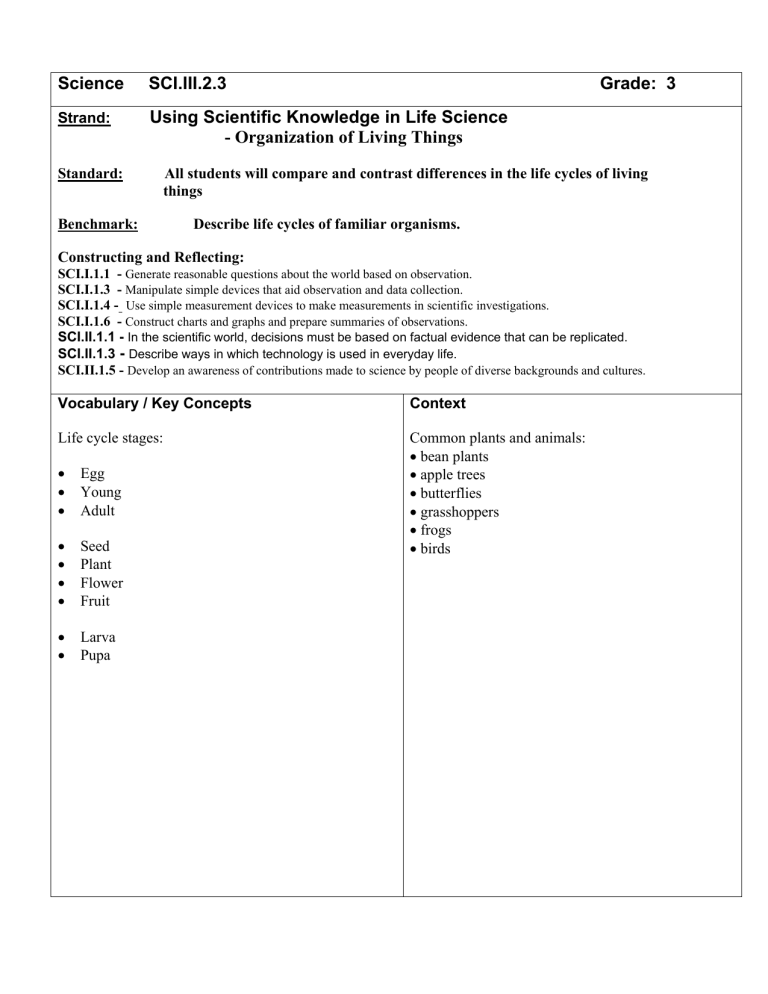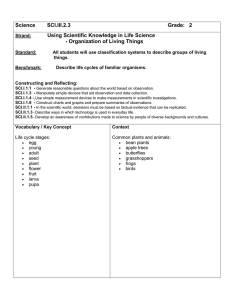Science SCI.III.2.3 Grade: 3

Science SCI.III.2.3 Grade: 3
Strand:
Using Scientific Knowledge in Life Science
- Organization of Living Things
Standard: All students will compare and contrast differences in the life cycles of living
things
Benchmark: Describe life cycles of familiar organisms.
Constructing and Reflecting:
SCI.I.1.1 - Generate reasonable questions about the world based on observation.
SCI.I.1.3 - Manipulate simple devices that aid observation and data collection.
SCI.I.1.4 Use simple measurement devices to make measurements in scientific investigations.
SCI.I.1.6 - Construct charts and graphs and prepare summaries of observations.
SCI.II.1.1 - In the scientific world, decisions must be based on factual evidence that can be replicated.
SCI.II.1.3
- Describe ways in which technology is used in everyday life.
SCI.II.1.5 - Develop an awareness of contributions made to science by people of diverse backgrounds and cultures.
Vocabulary / Key Concepts Context
Life cycle stages:
•
Egg
•
Young
•
Adult
Common plants and animals:
•
bean plants
•
apple trees
•
butterflies
•
grasshoppers
•
frogs
•
birds
•
Seed
•
Plant
•
Flower
•
Fruit
•
Larva
•
Pupa
Knowledge and Skills
A life cycle is a series of continuous phases through which all living things (organisms) go.
Students will organize the life cycle stages of a common plant or the life cycle stages of an animal.
•
Plants (seed, plant, flower, fruit)
•
Animals (eggs, young, adult) (egg, larva, pupa, adult)
Note:
Discover the Wonder does not include information on life cycles (see Resources for needed items).
Resources
Coloma Resources:
Discover the Wonder (Scott Foresman) – Grade 3
Module A – Chapter 2
Need:
6 Monarch life cycle posters (NASCO)
2 Butterfly Pavilions (Classroom Connect)
Other Resources:
Life cycle posters and books.
Eric, Carle. The Hungry Caterpillar (Revised version with Chrysalis)
Butter Fly Migration www.learner.org/jnorth/orientation.About.html
Videoconferences Available
For more information, see www.remc11.k12.mi.us/dl or call Janine Lim 471-7725x101 or email jlim@remc11.k12.mi.us
3.2.3
Butterfly Habits from the Camden Children's Garden
Hungry, Hungry Caterpillar from the Camden
Children's Garden
Spiders from the Center for Puppetry Arts
Butterflies from the Center for Puppetry Arts
The Wonderful World of Bugs from the Cincinnati
Zoo
A Seed Grows from the Minnetrista Cultural Center
& Oakhurst Gardens
Monarch Mania from the Minnetrista Cultural Center
& Oakhurst Gardens
Butterflies: Flights of Fancy from the Indianapolis
Zoo
Instruction
Benchmark Question: How do life cycles of living things differ?
Focus Question: How do plants change as they grow?
Together, the students plant (bean) seeds and create a routine to care for and observe the plants.
Students observe the plant using as many of the five senses as possible. The class begins recording common observations in a journal as modeled by the teacher. Use of computers or digital cameras would be appropriate. More mature students may record their own observations over a series of days/months.
Students measure the growth of the plant on a daily basis over several weeks and record the information they gather using a table which could be the basis for a student generated graph.
Students draw and label (classify) the four stages
(seed, plant, flower, fruit) of the plant life cycle they have observed.
Example of life cycle graphic:
Assessment
Students draw a comic strip showing life cycle stages of a plant or animal. Each panel of the comic strip should correspond to one stage in the plant or animal’s life cycle. Comics must include speech bubbles explaining the stage and what is happening to the organism.
(Give students rubric before activity.)
Scoring Rubric
Criteria
Correctness of order
Completeness of explanation
Apprentice
Draws at least one life cycle stage.
Draws at least two life cycle stages in order.
Draws all life cycle stages in order.
Draws all life cycle stages in order and includes proper habitat-or-
Expands on one or more of the life cycle stages.
Writes life cycle stage explanation for one drawing.
Basic
Writes life cycle stage explanations for drawings.
Meets
Writes life cycle stage explanations for drawings.
Exceeds
Writes a detailed life cycle stage explanation for each drawing.
Includes explanation of organisms’ habitats.
Teacher Notes:
Compare and contrast differences in the life cycles of living things.
Just as diversity and change are important features of the continuance of life on earth, cycles are a recurring theme at all levels of organization of living things. The "Cycle of Life" is perhaps the most commonly known of the biological cycles. The birth, growth, reproduction, and death of organisms within a species occur with regular predictability. At the elementary level, the life cycles of familiar organisms both plants and animals are the focus. At the high school level, the life cycle of organisms associated with human disease can be included in the investigations.




